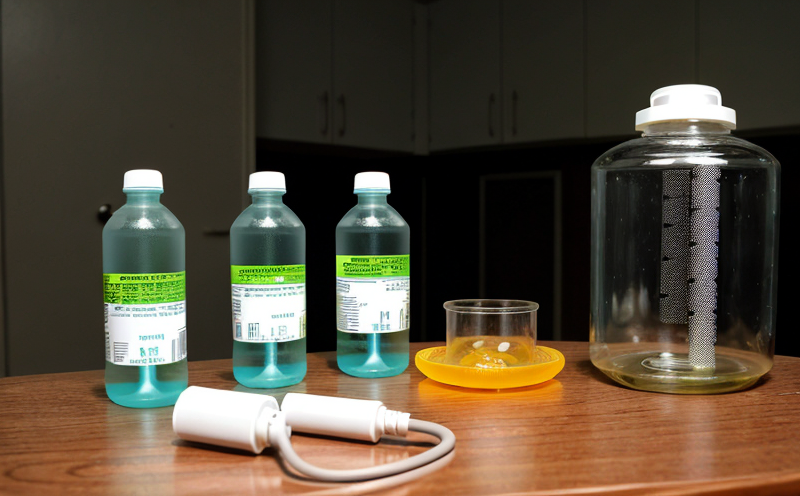ASTM D7287 Plutonium 239 Determination Test in Water
The ASTM D7287 test method is designed to accurately and precisely determine the concentration of plutonium-239 (Pu-239) in water samples. This is a critical standard used by laboratories, quality assurance teams, and regulatory bodies to ensure compliance with environmental protection laws and standards.
Plutonium-239 is one of the primary isotopes produced during nuclear fuel reprocessing and is also found as a result of atmospheric testing or accidental releases from nuclear facilities. Due to its high toxicity and long half-life (24,100 years), it is essential that water supplies are regularly tested for plutonium contamination.
The ASTM D7287 method employs gamma spectroscopy, which involves the measurement of gamma radiation emitted by plutonium-239 isotopes. This technique ensures accurate quantification and identification even in trace amounts. The test can detect levels as low as 0.1 picocuries per liter (pCi/L), making it highly sensitive for environmental monitoring.
The following steps outline the procedure for performing an ASTM D7287 Pu-239 determination:
- Sample Collection and Preservation: Samples are collected using sterile, acid-washed containers. Samples must be stored at 4°C to prevent degradation of Pu isotopes.
- Preparation: The water sample is passed through a filter to remove particulate matter and then digested with nitric acid. This step ensures that the plutonium-239 is in solution form for analysis.
- Spectroscopy Analysis: The prepared sample is analyzed using gamma spectroscopy, which involves irradiating the sample with X-rays or gamma rays to produce characteristic emissions from Pu-239 isotopes. This method allows for precise quantification of plutonium levels.
The test results are reported in units of picocuries per liter (pCi/L), which is a standard unit for measuring radioactivity. Reporting typically includes the detected concentration, background radiation data, and any relevant metadata about the sample collection process.
Understanding the significance of this test is crucial for those involved in environmental protection, water quality management, and nuclear safety:
- Environmental Protection: Ensures compliance with international regulations such as the EPA Uranium Standard.
- Water Quality Management: Helps in identifying and mitigating potential health risks associated with plutonium contamination.
- Nuclear Safety: Essential for monitoring nuclear facilities and ensuring that radioactive materials do not seep into groundwater or surface water.
The ASTM D7287 method is widely used across various sectors, including public utilities, environmental agencies, and private laboratories. Its application in these domains underscores the importance of accurate and reliable radioactivity testing.
| Application Area | Description |
|---|---|
| Public Utilities | Ensures compliance with international standards for water quality and safety. |
| Environmental Agencies | Contributes to the monitoring of radioactive contamination in natural ecosystems. |
| Nuclear Power Plants | Monitors effluent streams to ensure that plutonium does not escape into the environment. |
| Reprocessing Facilities | Verifies the effectiveness of waste treatment processes and ensures compliance with regulatory limits. |
Why It Matters
The detection of plutonium-239 in water samples is crucial for several reasons:
- Health Risks: Plutonium-239 can accumulate in the body through inhalation or ingestion, posing significant health risks.
- Environmental Impact: Long-term exposure to plutonium-contaminated water can lead to widespread ecological damage.
- Regulatory Compliance: Many countries have strict regulations regarding the permissible levels of radioactivity in drinking water and surface water.
The ASTM D7287 method plays a vital role in minimizing these risks by providing accurate and reliable data on plutonium-239 concentrations. This information is essential for making informed decisions about water treatment processes, waste management strategies, and environmental protection measures.
By adhering to this standard, laboratories ensure that their test results are consistent with international best practices. This consistency is critical in maintaining public trust and ensuring that regulatory bodies have the confidence needed to make appropriate policy decisions.
Industry Applications
The ASTM D7287 test method finds application across multiple industries, including:
- Nuclear Power Plants: Monitoring effluent streams and ensuring compliance with environmental protection laws.
- Reprocessing Facilities: Verifying the effectiveness of waste treatment processes and ensuring regulatory limits are met.
- Public Utilities: Ensuring water quality standards are upheld to protect public health.
- Environmental Agencies: Conducting comprehensive environmental monitoring programs for radioactive contamination.
- Research Institutions: Supporting scientific research into the behavior and impact of plutonium in aquatic environments.
In each of these applications, the ASTM D7287 method provides critical data that informs decision-making processes and ensures compliance with regulatory standards.
Quality and Reliability Assurance
- Certification: Laboratories performing ASTM D7287 testing must be certified by recognized bodies to ensure the accuracy and reliability of their results.
- Calibration: Instruments used in the testing process are regularly calibrated against known standards to maintain precision.
- Data Validation: Results from multiple tests are compared to validate consistency and accuracy. This ensures that any detected plutonium-239 is not a result of measurement error.
- Quality Control: Strict quality control measures are in place to ensure that all samples are handled and analyzed according to the prescribed ASTM D7287 protocol.
The combination of these measures ensures that laboratories can provide reliable data on plutonium-239 concentrations, which is essential for maintaining public health and environmental safety.





